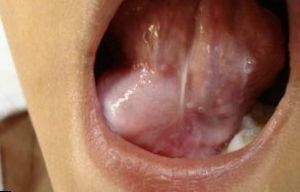 There is a large number of diseases that affect the oral cavity of a person. A fairly common problem is the salivary gland cyst.
There is a large number of diseases that affect the oral cavity of a person. A fairly common problem is the salivary gland cyst.
This disease develops as a result of blockage of the ducts of the salivary glands.
Contents
- What is the formation of cysts associated with?
- In the risk zone both small and large
- Nature of the clinical picture
- Diagnostic methods
- Medical assistance
- Traditional medicine
- Forecast and probable consequences
- Preventive measures
What is the formation of the cyst?
Often the problem is tied to the impossibility of outflow of a secret or due to its partial blocking. This is due to the appearance of a kind of blocking plug.
This phenomenon is typical for mechanical damage to the salivary gland by an injured incisor, foreign body or inflammatory process. Often, the formation of a plug can be a complication of the inflammatory process.
There are other reasons: a tumor that presses the outflow channel, cicatrical narrowing, excessive secretion of secret, which provokes 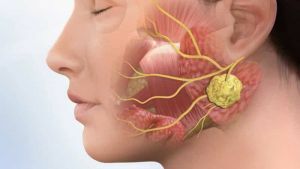 formation of salivary stone.
formation of salivary stone.
There is an assumption that the formation of a cyst can occur in infants still in the womb.
Over time, the cyst may increase in size. This is due to the accumulation of secretion in the obliterated cavity. In addition, it can be the result of the fluid's transudation, which occurs through the walls of the capillaries.
In the risk zone, both small and large
The cyst can develop both in the area of small salivary glands and large, the cavities are true( retentional) and false( traumatic).
The defeat of small salivary glands( palatine, molar, buccal, lingual and labial areas) is not a source of pain. It is possible to extract a secret during mechanical action on the formation, but over time the contents accumulate anew.
The cyst of the large salivary glands manifests itself in the following way depending on the location:
- sublingual cyst is spontaneously emptied from time to time, but from time to time is filled with a transparent secret;accompanied by an asymmetry of the contour of the face, increases with time;
- Parotid salivary gland can be infected, and as a result complications such as cysts, abscess occur, pains appear in the affected area, when the mouth opens, discomfort appears that limits movement, and skin hyperemia, subfebrile and fluctuation develops;
- of the cyst of the submandibular of the salivary gland does not have a clear symptomatology, with time the formation increases and at later stages causes more visible symptoms - asymmetry of the contour of the face.
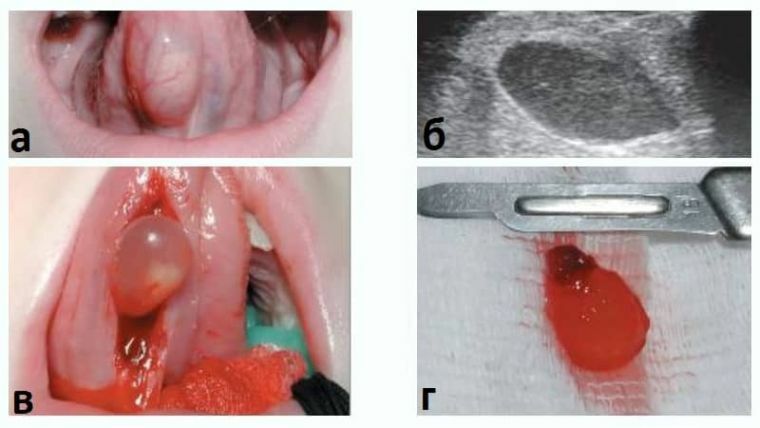
Cyst of submandibular salivary gland in real life, on ultrasound, in the process of removal and after surgery( photo a-b-in-g, respectively).
In addition, the cyst can affect both the ducts of the salivary glands and the parenchyma. In the diagnosis of an important role played by the structure of the cyst. Depending on the results obtained, it can be post-traumatic, that is, false, or retentional, that is, true.
Nature of the clinical picture
In the initial stages, the tumor has a small rounded shape. Over time, it begins to increase, and for this reason, it is not required.
In later stages, a pain syndrome develops, which develops in the event of pressure on the affected area or just any mechanical action. Thus, when eating, talking and palpating, discomfort occurs.
There are other signs that differ depending on the location of the formation:
- When lesions of small salivary gland the size of the cyst is not more than one centimeter. It is characterized by slow growth. Education is mobile and has a rounded shape, as well as an elastic consistency that rises above the mucosa.
- The formation of an oval or rounded form with a bluish color is observed in the sublingual area. Over time, the
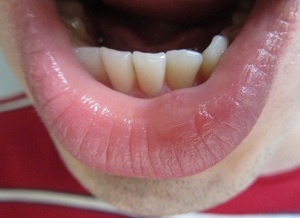 cyst may increase, in this case the bridle of the tongue is displaced, and this triggers speech problems and discomfort at meal time. Inside the cavity is filled with a transparent secret.
cyst may increase, in this case the bridle of the tongue is displaced, and this triggers speech problems and discomfort at meal time. Inside the cavity is filled with a transparent secret. - A rounded, fluctuating, soft, elastic formation may appear in the submandibular portion of the large salivary gland. May increase with time, resulting in deformation of the contour of the face.
- In the region of the parotid , the salivary glands of the cyst is manifested by the swelling of the soft tissues of a rounded shape. Often occurs on the one hand, due to which asymmetry of the face is observed. When palpation is noted as mildly elastic or densely elastic formation. Visible symptoms on the skin are not observed, in fact, as there is no pain syndrome.
Diagnostic methods
 The basis for diagnosing the disease is the clinical picture. In addition, laboratory and instrumental studies are carried out. Additional measures are also taken to find out some important factors concerning the cyst, to clarify its magnitude, position and connection with the salivary gland: ultrasound, sialography, cystography, MRI and CT.
The basis for diagnosing the disease is the clinical picture. In addition, laboratory and instrumental studies are carried out. Additional measures are also taken to find out some important factors concerning the cyst, to clarify its magnitude, position and connection with the salivary gland: ultrasound, sialography, cystography, MRI and CT.
When diagnosing for completeness and reliability of the information received, fine needle aspiration biopsy and puncture are performed. Subsequently, the contents are susceptible to cytological and biochemical studies.
Medical care
Treatment of salivary gland cysts with medication and other conservative methods is not effective.
Therefore, with the formation of cysts in the salivary gland, the latter is removed, often with nearby tissues. In this case an important role is played by the place in which the formation has appeared, since this affects the way of penetration during the operation to the area that requires removal. Currently, surgical intervention is carried out through the intraoral or external pathway.
If the formation is removed in the region of the large salivary gland, the operation is performed through external, open access, in the case of a small one - through the intraoral.
Carrying out the operation on the small salivary gland region implies the formation of the formation under local anesthesia from the oral cavity. In this case, catgut stitches are applied. In the course of surgical treatment of the sublingual cyst, cystosialoadectomy, cystostomy and cystectomy can be performed.
In some cases, the formation is removed together with the gland, often this occurs when the submandibular region is affected. Together with the parenchyma of the gland through the external access, the cyst located in the parotid region is also removed, but the branches of the facial nerve are preserved.
Traditional medicine
The methods of traditional medicine are also applied for treatment. Many patients simply refuse surgical intervention( because of fear or financial status), so they can use alternative medicine at home. All recipes of traditional medicine are aimed at removing the inflammatory process in the ducts. Among the most effective recipes it is worth noting:
- For treatment, a rinse solution can be used. To cook it you need 2 tbsp.l.eucalyptus essential oil, which should be diluted in a glass of warm water. In a day you need to spend 3-4 sessions.
- An excellent means for rinsing is the grass of a blue-head. This will require a glass of boiling water and a tablespoon of the plant. Use the decoction can be after 2 hours of infusion in a strained and cooled form.

- For decoction, you can use many other medicinal herbs that have a healing and anti-inflammatory effect. For example, the leaves are eucalyptus, raspberries, viburnum, sage, aloe, yarrow, elderberry, immortelle, chamomile, calendula, horsetail and other plants. At the same time, the proportions are the same as in the previous versions.
- Effective is a solution of half a teaspoon of iodized salt and the same amount of soda. The water in this case will need about a glass.
Prognosis and probable consequences of
During surgery, there is a risk that the branches of the facial nerve will be damaged. In order to avoid this, it is required to choose an 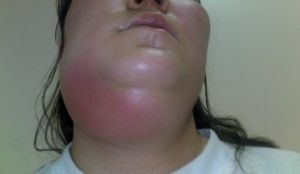 a good specialist, otherwise there is a chance of paralysis of facial muscles.
a good specialist, otherwise there is a chance of paralysis of facial muscles.
There is a possibility of incomplete removal of education, in this case the disease can recur. If treatment has not been started in time, then on the background of the cyst may develop phlegmon or abscess.
Given the timely identification of the problem and its professional treatment, the outlook is positive. In addition, for the operation to have the desired effect, all the prescriptions of the attending physician must be followed.
Preventive measures
First of all, to prevent the appearance of cysts, careful treatment of your body is required. It is necessary to avoid injury to the oral cavity, prevent inflammation.
In addition, it is necessary to regularly undergo examination at the dentist and resort to the help of dental hygienists. In addition to all of the above, to maintain the body for many years, it requires a healthy lifestyle.
With the right approach to its condition, in most cases it is possible to prevent or to arrest the disease at an early stage of development.
